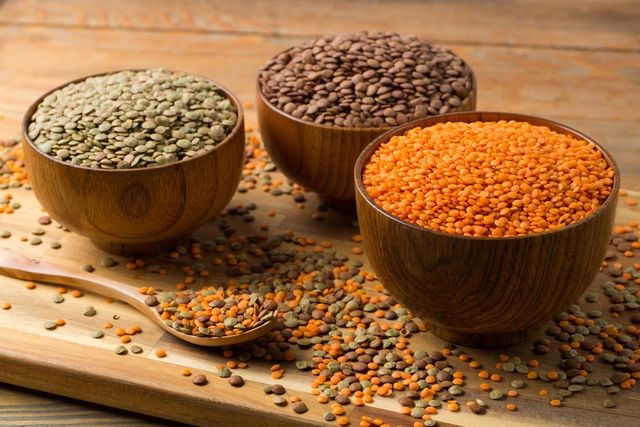Lentils are a powerhouse legume, as they are a great source of protein, vitamins and minerals. These nutrients can provide several health benefits, such as lowering cholesterol, promoting muscle gains, strengthening immunity and preventing conditions like anemia.
Lentils are also rich in fiber, which can keep you fuller and reduce hunger throughout the day. They are a great option to include in weight loss diets.
There are different types of lentils, such as green, red, brown, black, yellow or orange, which vary in thickness and cooking time. This legume is sold with or without its peel, and can be used in preparations such as soups, salads, rice and stews.

Health benefits
The main benefits of lentils include:
1. Promoting muscle gains
Lentils are rich in protein, which can lead to increased muscle mass, especially when consumed with rice, pasta or quinoa. Lentils with these grains can help to ensure an optimal amount of essential amino acids that promote muscle formation.
Also recommended: 16 Muscle-Building Foods to Eat to Gain Muscle (w/ Meal Plan) tuasaude.com/en/muscle-building-foodsLentils are also rich in iron, a mineral that improves oxygen transport in the blood. This can help boost physical performance and also promote muscle formation.
2. Lowering cholesterol levels
Lentils help reduce blood cholesterol levels, as they are a source of soluble and insoluble fiber, which reduces the absorption of fats in the intestine, in addition to increasing the secretion of bile acids, inhibiting the production of cholesterol in the liver.
3. Promoting weight loss
As a legume rich in fiber, lentils promote weight loss as they slow down the digestion of food in the stomach, prolonging satiety throughout the day and reducing hunger.
However, to lose weight it is also essential to maintain a healthy, low-calorie diet and practice physical activity regularly. Discover ARTICLE MAPPED FOR EN: other tips for losing weight.
4. Preventing anemia
Lentils prevent anemia because they have excellent amounts of iron, a mineral that acts in the production of hemoglobin, which is the component responsible for transporting oxygen from the lungs to the entire body.
Furthermore, lentils are rich in ARTICLE NOT FOUND IN EN: folic acid, a vitamin that promotes the formation of blood cells, therefore helping to prevent anemia.
5. Fighting constipation
Because it is rich in fiber, lentils increase stool volume and stimulate natural bowel movements, combating constipation. Check out ARTICLE NOT FOUND IN EN: other foods that combat constipation.
6. Boosting immunity
Lentils are rich in proteins, which are essential nutrients for the formation of the body's defense cells, therefore helping to strengthen the immune system and helping to prevent diseases and infections.
7. Relieving PMS and menopause symptoms
Because it contains lignans and isoflavones, which are bioactive compounds with properties similar to estrogenic hormones, lentils help regulate female hormones, relieving symptoms of menopause and PMS, such as hot flashes and mood changes.
8. Maintaining cardiac health
Lentils maintain heart health because they contain isoflavones and polyphenols, which are bioactive compounds with antioxidant action, which reduce cholesterol and triglyceride levels in the blood, preventing diseases such as atherosclerosis and heart attack.
Furthermore, the bioactive compounds present in lentils also inhibit levels of angiotensin I, an enzyme that stimulates water retention in the body, favoring an increase in blood pressure.
9. Preventing diabetes
Lentils help prevent diabetes, because they are rich in fiber that slows down the absorption of carbohydrates, balancing blood sugar levels and preventing insulin resistance.
10. Preventing osteoporosis
Because it contains isoflavones, lentils promote the production of hormones responsible for absorbing calcium into the bones, reducing bone loss and thus preventing osteoporosis.
11. Preventing cancer
Lentils help prevent the emergence of bowel cancer, because they are rich in fiber that serves as food for the beneficial bacteria in the intestine, improving the body's defenses and intestinal function.
Furthermore, the lignans, polyphenols and saponins present in lentils have antioxidant and anti-inflammatory effects, combating free radicals and helping to prevent the emergence of prostate and breast cancer.
Do lentils contain lithium?
It is believed that, as it contains lithium, lentils help in the prevention or treatment of depression, anxiety and bipolar disorder. However, lentils have low amounts of lithium, and there is still no recommended daily intake of lithium per day.
Furthermore, more scientific studies with humans are still needed to confirm whether the lithium present in foods is capable of preventing or helping to treat these disorders.
Can lentils cause weight gain?
Lentils are a fiber-rich legume that reduces food digestion time, prolonging satiety throughout the day and promoting weight loss. Furthermore, lentils are low in fat and, therefore, are a great food to include in weight loss diets.
However, when this legume is used in high-calorie recipes, such as fritters, with. sausage or bacon, for example, lentils can be fattening.
Nutritional information
The following table contains nutritional information for 100 g, equivalent to approximately 5 tablespoons, of lentils:
How to cook
To cook lentils, simply rinse them through water then place them in a bowl. Soak them in fresh water for 8 to 12 hours.
Then, discard the water, place the legumes in a pot and add enough water to cover them. Red lentils only require 5 minutes of cook time, while others require around 20 minutes.
Do lentils need to be soaked?
Lentils need to be soaked because they contain phytates, phytic acid and tannins, anti-nutritional compounds. When these are consumed in excess, they can cause excess gas and reduce the absorption of protein, iron and other nutrients.
Furthermore, it is also important to cook the lentils before consuming, as cooking also reduces the anti-nutritional factors present in them.
Contraindications for lentils
People with irritable bowel syndrome should avoid lentils, as this legume contains carbohydrates that are difficult to digest and can cause bloating, gas and diarrhea.
Lentils also increase intestinal gas production, which can cause cause discomfort. Therefore, lentils should be avoided by anyone with diarrhea and ulcerative colitis.
Healthy lentil recipes

Check-out some healthy and tasty recipes using this legume below:
1. Lentil soup
Ingredients:
- 1 cup of soaked lentils
- 1 onion, chopped into cubes
- 1 medium potato, peeled and cut into cubes
- 2 cloves of chopped garlic
- ½ cup of grated carrot
- 4 cups of water
- 2 tablespoons of olive oil
- 2 bay leaves
- Salt and black pepper to taste
Directions
Add 1 tablespoon of olive oil, onion and salt to a pot, and heat over medium heat. Sauté for about 3 minutes or until the onion is golden. Add the rest of the olive oil, bay leaves, cumin and carrot, and sauté for another 3 minutes.
Add the water, lentils, potatoes and black pepper, mixing well and increasing the heat. Once it starts to boil, lower the heat and let it cook for 15 minutes or until the potatoes and lentils are soft. Remove from heat and serve immediately.
2. Lentil rice
Ingredients:
- 1 cup of soaked lentils
- 2 cups of rice (rinsed in water)
- 1 tablespoon of olive oil
- 2 cloves of chopped garlic
- 3 cups of water
- 1 bay leaf
- Salt and black pepper to taste
Directions
Add the olive oil and garlic cloves to a pot and sauté for 2 minutes over medium heat. Add the rice and lentils, sautéing for another 3 minutes. Add the water, salt, bay leaf and black pepper, and mix all the ingredients well. Cover the pot and cook until the rice and lentils are soft. If necessary, more water can be added during cooking.
3. Lentil and potato salad
Ingredients:
- 100g of soaked lentils
- 450 g of potatoes, peeled and cut into cubes
- 1 medium onion chopped into small cubes
- 1 tablespoon of olive oil
- 2 tablespoons of balsamic vinegar
- Salt and pepper to taste
Directions
Place the lentils in a pot and cover with water. Cook for 20 minutes or until soft. Drain the lentils and set aside. In another pot, place the potatoes in boiling water and cook for 10 minutes or until they are al dente. Drain the potatoes and place them on a platter. Add the onions, lentils, oil, vinegar, salt and pepper, mixing well and then serve.
